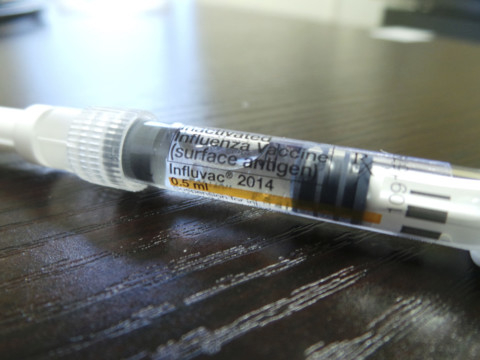
Yes, you should get a flu vaccine. No, they are not all the same.
The flu. Fever, chills, aches and pains, and sometimes gobs of snot. Usually there is nothing you can do but lie in bed, take some aspirin and sip chicken soup. Sometimes flu is a set-up for serious complications such as bacterial pneumonia; in some people, flu can worsen chronic conditions such as asthma and chronic obstructive pulmonary disease.
The best protection, of course, is to get ahead of the virus with a flu vaccine. But which one? The shot or the nasal spray? High-dose or recombinant? In recent years, new versions have led to better choices for young children, senior citizens, people with egg allergies and people who fear needles. Because fewer than half of Americans got vaccinated last year, according to the Centers for Disease Control and Prevention, anything that leads more people to get vaccinated is a good idea.
“As a health-care provider, my job is easier when my patients don’t get flu,” says Sandra Fryhofer, an Atlanta physician who serves on the American College of Physicians’ immunisation committee. “I am thrilled to have so many choices.”
Doses of flu vaccine are formulated based on infectious-disease experts’ best guess at which strains will be circulating in the coming season, which can start as early as this month. Vaccination is recommended for all Americans over the age of 6 months; vaccines are distributed widely and offered at doctors’ offices, drugstores and workplaces.
Here is a closer look at some of your vaccine options. Remember, public-health experts say any vaccine is better than none, and the sooner you get vaccinated the better.
1) The basic flu shot, injected into the muscle of the arm. The majority of flu vaccines this year (as in recent years) have been trivalent, which means they protect against three major flu strains: influenza virus A of the H1N1 type, influenza virus A of the H3N2 type and influenza B virus. The vaccine is made by growing flu viruses in chicken eggs, then killing the virus and purifying key components — proteins, called antigens, that stimulate the human body to make antibodies.
2) The quadrivalent vaccine. This upgrade of the basic flu shot protects against the trivalent’s three strains plus an additional influenza B virus and is being phased in by a couple of manufacturers.
3) The nasal spray. This quadrivalent vaccine is the preferred formulation for children aged 2 to 8 based on data showing that children are protected better by the nasal spray.
Unlike other vaccines, the nasal spray delivers the whole virus, alive but in a weakened state. “It only works in the nose — it can’t survive at internal body temperature,” says Lisa Jackson, a physician researcher at Group Health Research Institute in Seattle. “It acts like a regular infection and prompts a more robust immune response.”
4) The high-dose flu vaccine. A recent addition to the vaccine armamentarium, this contains four times the amount of viral components as the standard vaccine and is approved for people who are at least 65 years old. The extra antigens trigger a bigger immune response, which is especially helpful in older people, who typically have less responsive immune systems.
Research published in August in the New England Journal of Medicine showed that the high-dose vaccine worked 24 per cent better in protecting senior citizens against flu than did the standard dose over the course of two flu seasons.
That is a modest improvement, Jackson says, though that may provide a significant payoff in the elderly, who are at greater risk of complications from flu, including more hospitalisations and more deaths. However it also costs about twice as much as the standard flu shot. “Health administrators may be wondering whether it’s worth it,” she says. “As a clinician, I think it’s worth it.”
5) The recombinant vaccine. A recent formulation of the trivalent vaccine that is made without eggs (insect cells are used in one step) and is safe for people aged 18 to 49 with severe egg allergies.
6) The PharmaJet-delivered vaccine. A needle-free injection system for the trivalent flu vaccine. Approved in August by the Food and Drug Administration for people aged 18 to 64, the device, called a jet injector, delivers the vaccine as a fine stream with enough pressure to puncture the skin.
7) The intradermal shot. A vaccine that delivers flu antigens under the skin, not into the muscle. This shot uses a much smaller needle — helpful for people made anxious by needles — and it allows a smaller dose of vaccine to be injected, which may be helpful in times of vaccine shortage. It has not been widely adopted, in part because intradermal injections require more skill by the person administering the shot, Jackson says.
Your doctor can help you sort through the choices to find the best vaccine for you. “Patients come in with different fears,” Fryhofer says. “Some are scared of needles and others want maximum protection.”
When you think about it, it seems odd that you would give the same vaccine to a 65-year-old and a 5-year-old, Jackson says. “The one-size-fits-all approach doesn’t really make sense.”
Despite the variety of options, it remains true that flu vaccines are not 100 per cent effective. “It depends on the match of circulating strains to the vaccine, and it depends on your own immune response to the vaccine,” Fryhofer says.
For this reason, it is wise to follow basic protective measures, such as washing your hands frequently and steering clear of sick people during the winter months. These practices can also help you avoid cold viruses, for which there are no vaccines.
–Washington Post












